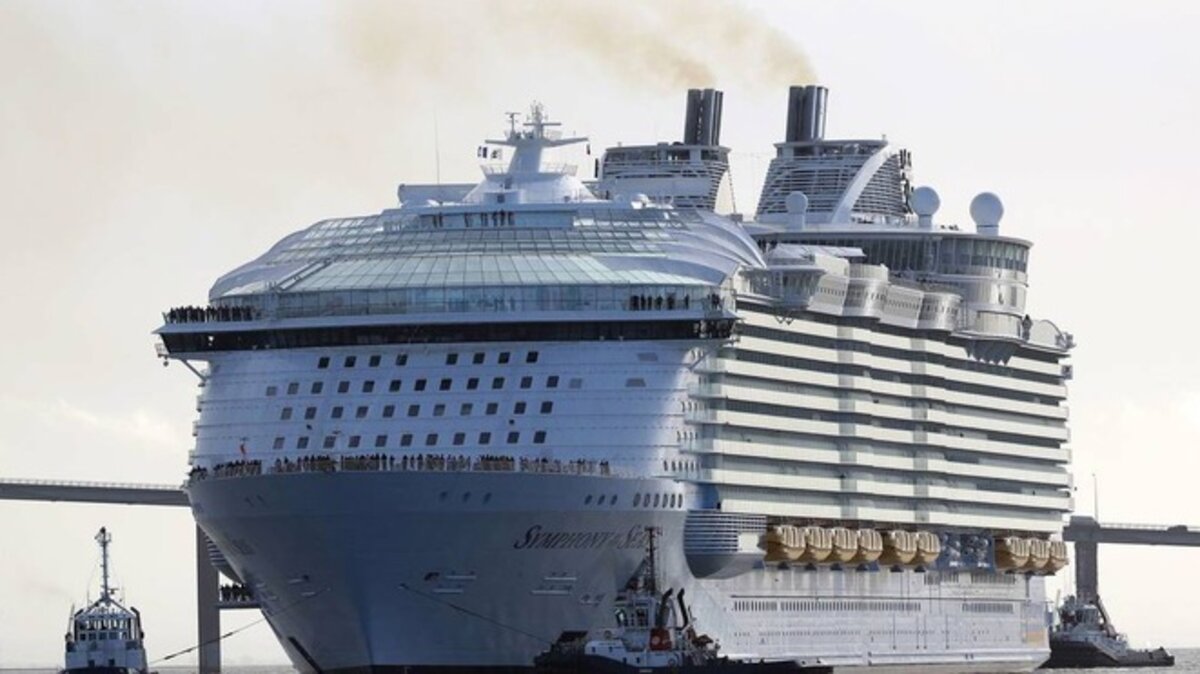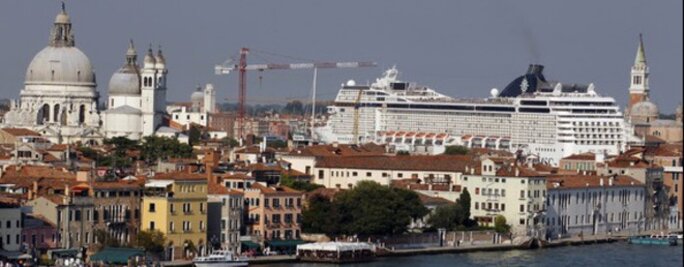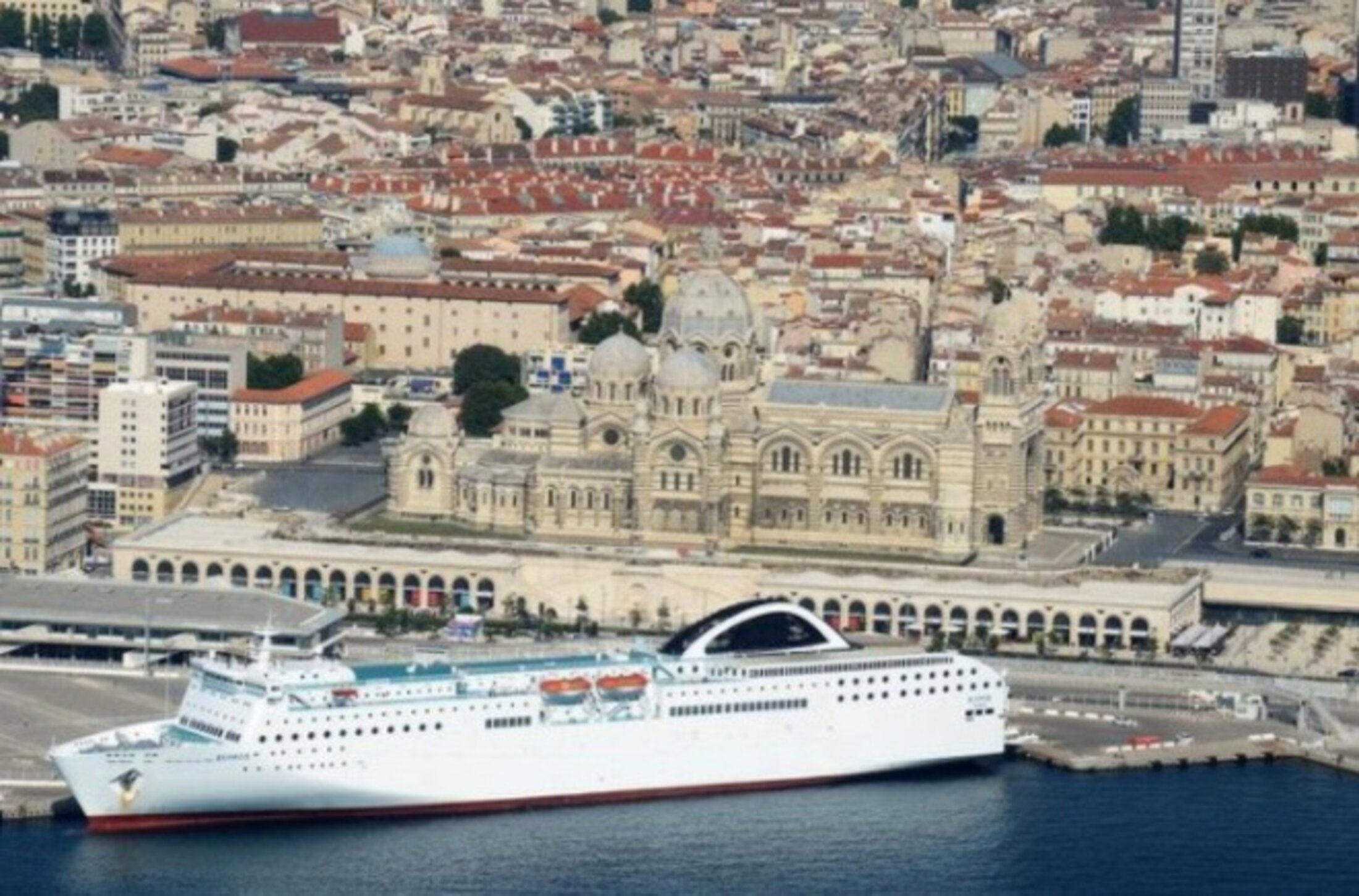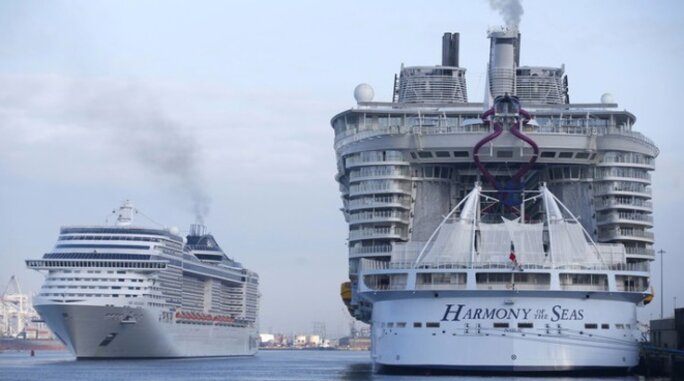At 362 metres long, 70 metres tall and 66 metres wide, the 18-deck Symphony of the Seas is, by gross tonnage, the largest cruise ship in the world, capable of carrying almost 6,700 passengers on top of her 2,200 crew.
Built at the STX naval shipyard in Saint-Nazaire, north-west France, the cruise ship was earlier this year handed over to its Florida-based owner Royal Caribbean Cruises Ltd and completed her maiden voyage last month in the Mediterranean Sea.
When the ship was delivered, STX proudly announced that it was designed to be more than 20% more energy efficient than its three STX-built Oasis-class predecessors, including the marginally smaller Harmony of the Seas, completed in Saint-Nazaire in 2016.

Enlargement : Illustration 1

Royal Caribbean (whose subsidiary Royal Caribbean International operates its fleet of cruise ships), is keen to underline its efforts to reduce the environmental effects of its vessels, from the replacement their of energy-guzzling incandescent light bulbs to the agreement it signed last year with the World Wildlife Fund to introduce measures such as reducing by a third its ships’ greenhouse gas emissions, as recorded in 2005, by 2020, and the use onboard of seafood acquired only from sustainable fishing.
But beyond such worthy aims, there remains an increasingly urgent issue to be tackled by the maritime transport sector, namely the air pollution caused by the shipping industry’s use of less refined, dirty fuel. While large ocean-going vessels, including cruise ships, now emit a little less carbon dioxide than before, they continue to funnel into the atmosphere largely the same amounts of sulphur oxides (SOx), and nitrogen oxides ((NOx), and ultrafine particles (UFPs) which are all dangerous pollutants.
Concerning cruise ships, the problem is aggravated by the fact that they largely navigate in warm regions, where the sun’s rays help form ‘secondary’ pollutants. Nitrogen oxides produce ozone. While ozone present in the stratosphere, at altitudes of between ten and 50 kilometres, helps protect from ultraviolet radiation, when it is formed in the low atmosphere it is toxic for the flora and fauna. In humans, it can cause pulmonary problems such as asthma.
But of most concern is the pollution caused by fine and ultrafine particles which are invisible to the eye. These were little recognised as a problem up until recent years, but it is now established that they represent a serious health risk. For while larger-sized particles are blocked by the nose and the mouth, fine particles – which are less than 2.5 micrometres in diameter – enter into the lungs. As for ultrafine particles, which are less than 1 micrometre, they are small enough to pass via the lungs into the bloodstream and are considered to represent not only a risk of respiratory disease but also a possible trigger of cancer and cardiovascular disease.
French environmental protection association France Nature Environnement (FNE) has teamed up with a German counterpart, the Nature and Biodiversity Conservation Union, to highlight the dangers of fine and ultrafine particles from cruise ships. They claim that this specific form of pollution typically emitted by a mid-sized cruise ship burning 150 tonnes of diesel fuel per day is the equivalent of that which would be caused by one million moving cars.

Enlargement : Illustration 2

Over three years between 2015 and 2017, the FNE and NABU went about measuring ultrafine particle (UFP) pollution in the port of Marseille in southern France, and which is the fourth most visited by cruise ships around the Mediterranean Sea basin. They used a UFP counter called the P-Track, made by US precision instrument manufacturer TSI. At the Pharo palace in the city, situated close to the historic old fishing port, they registered a concentration of 3,000 UFPs per cubic metre of air. But at the main maritime port, situated eight kilometres away, they found a result of 300,000 UFPs per cubic metre – one hundred times greater.
A similar scale of pollution was recorded on the upper deck of a cruise ship on the high seas in a test carried out last year by monthly French television programme Thalassa, produced by public channel France 3. An undercover reporter measured fine particle pollution in the air at different levels of the cruise ship (see video here, in French) which was not identified. On lower decks, and amid passengers lying on deck chairs, she recorded 109,000 particles per cubic metre. On the upper deck, where she was secretly filmed beside a lane for joggers which circles it, she found a concentration of 307,000 particles per cubic metre, which the programme said was a similar level to that found in central Paris amid rush-hour traffic.
The risks to most passengers spending just one or two weeks aboard is clearly minimal, but not for all; Brice Loddé, a doctor specialised in maritime healthcare at the university teaching hospital 5CHU) in Brest in north-west France, warns that those who are particularly vulnerable to air pollution, such as children, old folk and those with debilitating respiratory illnesses should avoid such concentrations.
But it is ships’ crews and the inhabitants of ports who are most exposed to the danger, even if they do not always recognise the fact. Jean-François Suhas is the president of the Marseille Provence Cruise Club which, in association with the Marseille city hall and the Marseille port authorities, promotes the development of cruise ship traffic in the port. “I live amid the smoke from ships since the age of 18 and I’m not ill,” he said. “None of my friends are either.”
But, Dr Loddé underlines, prolonged exposure to soot pollution, as are crews, can produce health effects that appear 20, or even 30 years afterwards. “To say that it is definitely pollution from boats that is responsible, so long afterwards, is complicated,” he cautions. It is all the more so given that crews can be exposed to aggravating factors like the pollutants in engine rooms, asbestos dust, or from smoking. Despite the confusion, Loddé observed that several studies into the effects of ship pollution have found “rather worrying figures”, which include higher rates of cancer of respiratory tracts among maritime staff than among the general population.

Enlargement : Illustration 3

A study co-published in 2016 by the German public research centre for environmental health, (the Helmholtz Zentrum München) and researchers from other scientific institutions in Germany, Luxembourg and Finland, came to the unequivocal conclusion that “ship emissions adversely affect the health of inhabitants of coastal regions”, and notably concerning cardiovascular and respiratory diseases. Other scientific studies have estimated that the causes of between 50,000 and 400,000 deaths worldwide each year can be linked to the effects of maritime air pollution.
AirPACA is the air pollution monitoring agency for the PACA region of south-east France that includes Marseille. Together with the Aix-Marseille university’s chemical environment laboratory, LCE, it has set up a pollution measuring station in the centre of Marseille with which they hope to determine where the different pollution particles come from. But because ultrafine particles are not included in current French legislation on pollution it records only fine particles. AirPACA director Dominique Robin says that pollution in the port is “far from being exclusively from maritime transport alone”. About 50 kilometres inland is one of Europe’s largest industrial zones, at the Fos Gulf. But this summer his agency will measure pollution in the Mourépiane district of the port, which lies opposite the main port terminal, and which will allow for a more precise official count of pollution from ship emissions.
The port estimates that a total of about 1.75 million passengers will embark and disembark on liners in Marseille in 2018 which, despite being an impressive number, is but a fraction of the more than 27 million people forecast to holiday on cruise ships around the world this year (up from 17.8 million in 2009), according to the the Cruise Lines International Association. The Mediterranean is the second most popular region for cruise tours, with 16% of world cruise traffic, behind the Caribbean, with 35%. In this growing economic sector, it is estimated that the cost of the average cruise ship is recouped after five years of service. The Marseille port authorities and local councils evidently see a bright future for the business, far more profitable than the tankers and container shipping that also use the port, investing over recent years in the renovation of the neighbourhoods surrounding the cruise ship terminal, the building of a shopping centre for passengers and the opening of a museum dedicated to the history of the Mediterranean basin.
Jean-François Suhas, president of the Marseille Provence Cruise Club, reckons that of the 328 cruise ships currently in service in the world, 82 will this year visit Marseille. During the cruise season, up to six of the vessels can be found at the quayside, their engines ticking over to supply the huge demand in electricity for the numerous attractions on board, from restaurants and casinos to ice rinks and ski runs.
Shipping of all sorts, from cruise ships to fishing boats to container carriers, uses mazut, a heavy, poor quality fuel oil that contains up to 3,500 times more sulphur than is found in diesel fuel for vehicles where its quantity is limited to 0.001% of the mixture. Mazut, a dirty oil, is viscous dark-brown residue that is left over from processing oil into finer fuels, and is about 30% cheaper. “The maritime sector has always been one of the principal users of residues from the distillation column,” explained Boris Fedorovsky is a technical advisor to the professional body that represents the French naval construction industry, the Groupement des industries de construction et activités navales (Gican). As he put it, the enormous engines on ships are “capable of burning anything”. The shipping industry and oil-fired power stations are the two industries that still use mazut.
The International Maritime Organisation, the UN agency that regulates international shipping activity, has at last taken position on the fuel composition used by ships, decreeing that by 2020 no vessel worldwide will be allowed to run on fuel that contains more than 0.5% of sulphur (a limit which is nevertheless still 500 times more than diesel used by vehicles). That may prove difficult to police, given that many large ships have several reservoirs containing different fuel mixes.
François Piccione is a specialist in ocean issues for the French environmental association FNE. He underlined the legal inequity in regulations for shipping in the north of France and that in the south, because while the maritime zones of the English Channel and the North Sea (like also the Baltic) were declared a Sulphur Emission Control Area (SECA) in 2015, by which ships are required to use fuel that contains less than 0.1% of sulphur content, shipping in the Mediterranean escapes this limitation. In the Mediterranean, passenger ships and ferries are allowed to use fuel with up to 1.5% of sulphur content, while tankers and container ships can burn fuel with up to 3.5% of sulphur.
Laurence Rouïl, a researcher specialised in pollution issues with the French environment ministry’s National Institute for Industrial Environment and Hazards (INERIS), said France has “taken the leadership” in attempting to clampdown on shipping pollution in the Mediterranean by pushing not only for it to be declared a SECA but also a NOx Emission Control Area, or NECA. A feasibility study has been commissioned from INERIS and other agencies to establish the health and financial effects this would have on coastal populations and for ship owners. “The difficulty with maritime transport is that it is necessary to gather the support of all the countries concerned,” said Rouïl. Around the Mediterranean, this would mean rallying countries like Syria or Libya which are unlikely to regard the introduction of such regulations as a priority, if indeed they were capable of enforcing them. Meanwhile Greece, with a large maritime fleet, currently faces such enormous economic problems that it is also unlikely to limit shipping traffic that does not meet the restrictions imposed by SECA and NECA regulations.
Dietmar Oeliger, in charge of maritime affairs for German environmental organisation NABU added that another problem is that states like Liberia or the Bahamas, where flag-of-convenience fleets which ply the world’s seas are registered, “are little interested in practices and the improvement of regulations”.
Environmentalists readily admit that of all the air pollution caused by shipping, which represents 90% of merchandise transport around the world, cruise ships are but a relatively very small part of the problem. But, said François Piccione of the association FNE, the cruise fleets are “more visible” as a means of drawing public attention to the issue. “Even if the merchant navy represents a greater problem, we cannot wait for regulation from the IMO,” said NABU’s Dietmar Oeliger. “Only public pressure can make things happen.”
The cruise industry, meanwhile, is naturally keen to defend itself from the attacks. Its representative body, the Cruise Lines International Association (CLIA) issued a statement in April claiming that cruise companies globally had invested more than 1 billion dollars (814.5 million euros) in new technologies and cleaner fuels, and underlines that cruise traffic around Europe represents but 1.2% of total emissions from ships in ports. Boris Fedorovsky of France’s naval construction industry federation GICAN insists that cruise ships are “more ecological than the others”, in part because they are also in general much more recent than those shifting merchandise. In a CLIA report published in August 2017, it estimated that about a quarter of cruise ships under construction will be driven by liquefied natural gas (LNG), an alternative fuel that is emits very little sulphur oxides and nitrogen oxides.
But for NABU’s Dietmar Oeliger, while he recognises that latest generation cruise ships currently in operation have improved standards from an environmental perspective, notably regarding wastewater treatment systems, he says he remains sceptical about efforts to curb air pollution. He claims very few have equipment for smoke treatment, such as soot particle filters or catalysers to reduce nitrogen oxide emissions. In the 2017 edition of a yearly table drawn up by NABU, of 34 cruise ships ranked according to their pollution-causing emissions, from the cleanest to the dirtiest, the Harmony of the Seas, completed in 2016, along with its two slightly older Oasis-class sister ships, came near to the bottom.

Enlargement : Illustration 4

While the cruise industry highlights the use of so-called “scrubbers” – exhaust gas cleaning systems (EGCS) which use sea water to clean out a ship’s exhaust channels – which can eliminate most of the sulphur oxide residue, the process has little effect upon nitrogen oxides and gets rid of only the largest particulates. Furthermore, the sulphur that is cleaned out is often dumped in the sea, aggravating the acidification of oceans which is so harmful to marine life. A European Commission report published last month highlighted the extent of the problem in the North Sea where EGCS waste dumping is widespread.
A European Parliament report in 2015 into emissions pollution caused by the aviation and maritime transport sectors projected that unless significant changes were brought about, carbon emissions from maritime transport would account for 17% of global carbon emissions by 2050 (compared to a projection of 22% for the aviation sector). The IMO last month finally found agreement from a majority of its more than 170 national representatives behind a pledge that global maritime transport will reduce current carbon emissions by half between now and 2050. The move had been opposed by a number of countries, including Saudi Arabia and Brazil, who mostly regarded the imposed changes as a threat to their economies. “The opposition comes from states which play a secondary role in the maritime transport industry and who oppose either for political reasons, either for motives linked to their economy – countries exporting oil, minerals or agricultural products sensitive to variations in the costs of maritime transport,” commented one French government source who asked not to be named. The IMO agreement represented a significant change after it had previously succeeded in removing the shipping sector from inclusion in the 2015 Paris COP 21 agreement on measures to reduce climate change.
Shortly before the agreement was announced by the IMO, a joint statement was issued by the environment minister of the Marshall Islands, a Pacific Ocean state threatened by rising sea levels, and Christiana Figueres, a Costa Rican diplomat who as a UN official played a key role in preparing the 2015 COP 21 accords. They underlined “significant compromises by countries – not least by vulnerable island nations which had been pushing for something far more ambitious", adding: “To get to this point has been hard – very hard.”
-------------------------
- The French version of this article can be found here.
English version with added reporting by Graham Tearse


